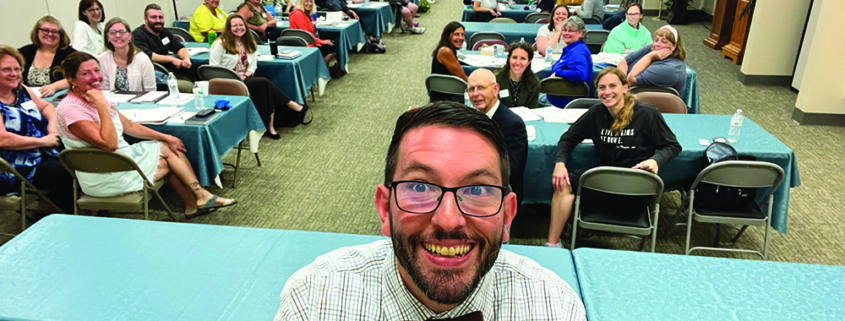Eucharistic Literacy: Forming Teachers as Effective Catechists
At Mass, you often see mothers whispering into the ears of their squirming toddlers. Occasionally you can catch the words, “Look, it’s Jesus!” Shortly after the consecration, the congregation echoes loudly this whispered declaration of faith, “Lamb of God, who takes away the sins of the word, have mercy on us.” Both confessions are needed to help the child see who is present on the altar; who is present to us in the Blessed Sacrament. Eucharistic literacy begins with the family and is supported by the parish family.
What, then, if these great truths learned at home and at Sunday Mass are largely forgotten the rest of the week? In secular schools, Christ is disregarded as irrelevant to daily life, and learning is focused on career readiness and a secular worldview that pretends Christ never redeemed the world. Perhaps, then, it is no surprise that most young adult Catholics who never had a strong Catholic education do not believe the Real Presence of Christ in the Eucharist.
There is a need for the Eucharistic revival, and Eucharistic literacy through Catholic education is a crucial component. The revival can take many approaches, but at Sophia Institute for Teachers, we have seen the importance of forming Catholic educators: parents, catechists, and teachers. This mission extends beyond giving them the tools to teach, but also inviting them to experience Divine Love through the Sacraments. How can teachers proclaim, “Look, it’s Jesus,” without knowing His gaze upon them?
There is much that Catholic schools, dioceses, and colleges can do to form educators who are already hired. Since 2014, the Sophia Institute has provided day-long catechetical workshops for tens of thousands of Catholic educators around the country, and we are happy with the impact of this simple solution. A theological scholar’s more intellectual sessions are balanced with practical, pedagogical sessions from a Sophia master teacher that model concrete ways to make these concepts present to the students. The teachers’ imaginations are fed, and then they are sent home with lesson plans to use with their students. But most importantly, there are sessions for reflection and prayer, with the Holy Mass at the center of the day.
At our recent workshop on the Eucharist called, Encountering God’s Love in the Sacraments, Franciscan University’s Dr. James Pauley made four points for teaching students during this Eucharistic Revival:
1 | teach and show them how to deeply invest,
2 | help them develop fluency in Sacramental language,
3 | help them see the Mass as the supreme encounter with love, and
4 | provide them a joyful witness to Jesus in the Eucharist.
All four of these points were incorporated into the pedagogical sessions hosted by our master teacher, Jose Gonzalez. He led teachers in meditating on the mysteries of the Eucharist through sacred art. They learned, some for the first time, about how the Old Testament revealed the gift of the Eucharist in the New Testament. And Jose drew on his experience to offer engaging ways to speak and teach about the Mass and the Liturgy. All these activities were ordered to the joyful experience of Holy Mass and Adoration together.
The results were encouraging: 93 percent of attendees reported feeling more confident and renewed in teaching the Faith, 89 percent gained new lesson ideas, and 93 percent learned new content about the Eucharist. These figures align with typical feedback from our workshops.
This is how we will see a genuine revival in our schools. Teachers of all subjects must see that the goal is not only familiarity with the doctrine of the Eucharist, but leading young people and their families to an authentic encounter with the Lord through the Eucharist. Strengthening Eucharistic literacy among students—helping them truly know and gain some understanding of the mysteries of the Eucharist—begins with hiring teachers who themselves are “literate” in the Church’s teaching and devotion to the Holy Sacrament. But just as ongoing formation is needed in all subjects, so is catechetical formation for all teachers.
We invite dioceses to schedule workshops with the Sophia Institute for Teachers, or schools and colleges can follow a similar model in their teacher formation programs. One key is to ensure that each workshop attendee leaves with all the tools they need to continue what they began. We provide multiple lesson plans, following the example of Our Lord by both informing and giving personal witness. Teachers tell their students, “Look, it’s Jesus!” by what they say, the content they teach, and how they behave. The lesson plans offer consistent support, guidance, and encouragement.
Just as ongoing formation is needed in all subjects, so is catechetical formation for all teachers
To help develop “fluency in Sacramental language,” as Dr. Pauley recommends, our Spirit of Truth series of lesson plans immerses the students in vocabulary from an early age. For example, we don’t wait until 5th or 7th grade to introduce the word “transubstantiation” but begin in 2nd grade, when most are preparing to receive First Communion. The students are guided to find the root of the word “substance” and make the connection with the word “transform,” even if the concept is not completely mastered for many years.
We hope that through the encounters with the Lord facilitated by these lessons, teachers will see their pivotal role in the classroom. The teacher stands alongside the parent, proclaiming to the children, “Look, it’s Jesus.” This requires a vibrant faith, fluency in the Sacramental language, and a personal connection with Christ. Belief in the Real Presence can only come from God by grace, but teachers can lead students to Him.

